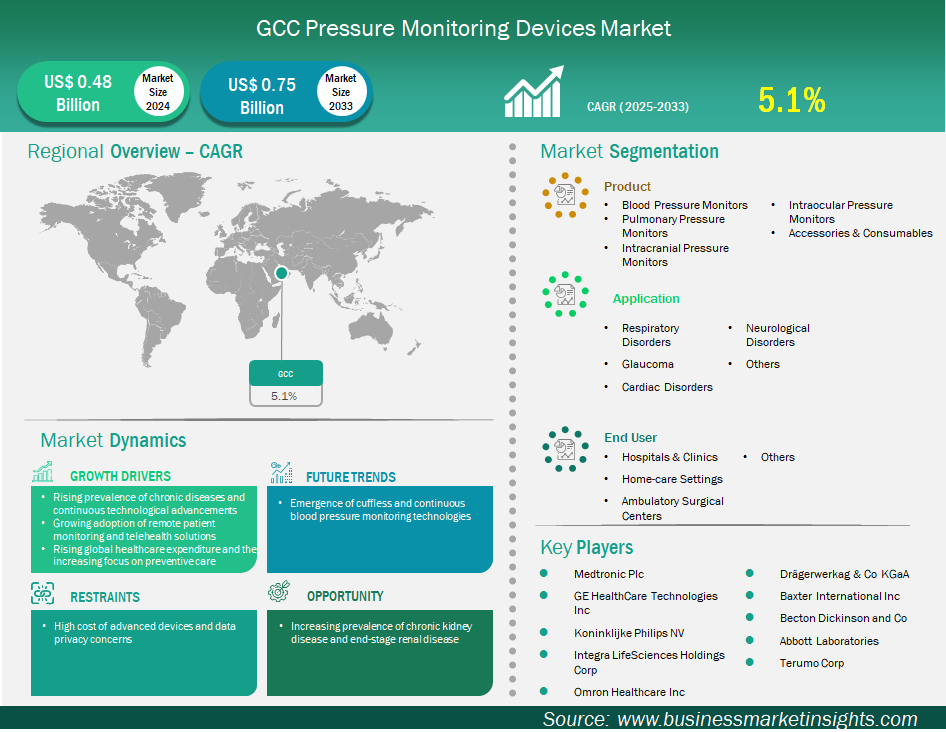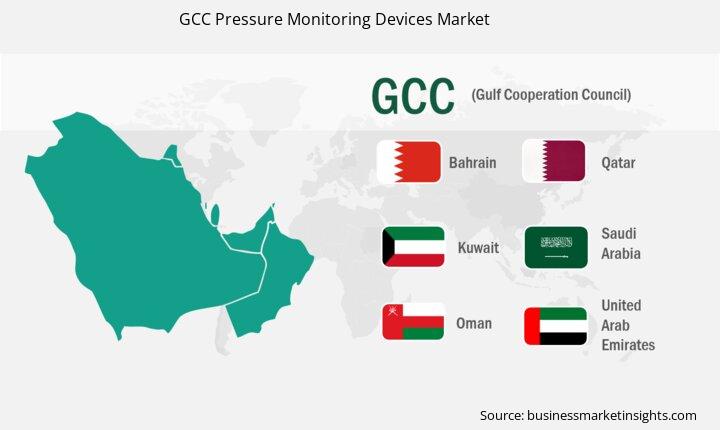GCC Pressure Monitoring Devices Market Outlook (2022-2033)
No. of Pages: 185 | Report Code: BMIPUB00031870 | Category: Life Sciences
No. of Pages: 185 | Report Code: BMIPUB00031870 | Category: Life Sciences
GCC pressure monitoring devices market size is expected to reach US$ 752.6 million by 2033 from US$ 480.1 million in 2024. The market is estimated to record a CAGR of 5.1% from 2025 to 2033.
The pressure monitoring devices market in the GCC is poised for rapid growth boosted by rising prevalence of chronic diseases and continuous technological advancements, growing adoption of remote patient monitoring and telehealth solutions, and rising global healthcare expenditure and the increasing focus on preventive care. The MENA (Middle East and North Africa) region, including the GCC, has the highest regional prevalence of diabetes with 1 In 5 adults with diabetes (85 million people) In 2024, which will grow to an estimated 163 million by 2050. While specific 2024 hypertension rates for all of the GCC countries are more difficult to ascertain from public sources, Saudi Arabia's hypertension-related morality rate in 2019 was 81.1 per 100k population and the UAE's was 64.7 per 100k population.
The high prevalence of these disease states is translating into significant overall demand for diagnostic and continuous pressure monitoring devices, from home blood pressure monitors to more advanced invasive monitoring systems in hospitals. The GCC governments have massive build and quality improvement program investments being made to bolster their healthcare infrastructure, often as part of larger national diversification initiatives.
GCC Pressure Monitoring Devices Market Strategic Insights

GCC Pressure Monitoring Devices Market Segmentation Analysis
Key segments that contributed to the derivation of the pressure monitoring devices market analysis are product, application, and end user.
The GCC pressure monitoring devices market is segmented into the UAE, Bahrain, Saudi Arabia, Oman, Qatar, and Kuwait. there is a growing strategic interest in localizing medical device manufacturing. Government-led diversification strategies aim to reduce import dependency and enhance self-sufficiency in medical supplies and equipment, although this is still in nascent stages for complex devices like pressure monitors. However, the strong investment climate and focus on establishing centers of excellence suggest future opportunities for localized production or assembly of high-demand medical devices. The rapid adoption of telemedicine and digital health solutions is a major trend. This shift facilitates the use of portable and connected pressure monitoring devices in home care settings, enabling remote patient monitoring and improving chronic disease management. For instance, the UAE's Ministry of Health and Prevention showcased AI-powered dashboards and digital health services at Arab Health 2024. Qatar's National Vision 2030 strongly emphasizes digital and high-tech solutions in healthcare, including telemedicine and EHRs.
Based on region, the GCC pressure monitoring devices market is further segmented into the UAE, Bahrain, Saudi Arabia, Oman, Qatar, and Kuwait. The Saudi Arabia held the largest share in 2024.
The Saudi and UAE as leading markets for CHE in the whole Mena region, with Saudi Arabia anticipated to have a CAGR of 8.8%, which is also different than the forecast of last year (2020). The Saudi Vision 2030 promotes a transformational healthcare agenda whereby focused on digital transformation, development of electronic health records (EHR5) and telemedicine - with hospitals the fastest end-use to grow in the healthcare information system during 2024.
The UAE healthcare is on an "amazing growth trajectory" and set to exceed $50 billion by 2029, significant investments in technology and variation of quality standards and $150 million from the government in 2024 for advanced new hospitals and clinics. Qatar has implemented the National Health Strategy 2024-2030, with vision is fully digital, refinement on research and development and finally accessing all patients on an integrated path. Kuwait is developing a "Medical City", a planned project cost of $802 million, which will service pensioners, 400 bed hospital and specialized centres. Bahrain's focused on investing in digital transformation - Preventative Health, Innovative medical solutions focused on patients, and made headlines and headlines by highlighting Oman's Health Vision 2040. Oman plans to utilize some improvement to health with expansive health project - such as moving towards Al Suwaiq Hospital being built will apply advanced medical equipment including (patient monitoring solutions). These broader focus of ongoing infrastructure increases will have a direct influence to increasing demand on various pressure monitoring devices. The aging population will face some challenges in the future (which isn't that much older than prior census sessions and certain regularity in governmental expense reports can clearly represent the opportunity vs attempted thoughtful or forethought investment similar on researcher development in the past.
GCC Pressure Monitoring Devices Market Report Highlights
Report Attribute
Details
Market size in 2024
US$ 480.1 Million
Market Size by 2033
US$ 752.6 Million
CAGR (2025 - 2033) 5.1%
Historical Data
2022-2023
Forecast period
2025-2033
Segments Covered
By Product
By End User
By Application
Regions and Countries Covered
GCC
Market leaders and key company profiles
GCC Pressure Monitoring Devices Market Company Profiles
Medtronic Plc, GE HealthCare Technologies Inc, Koninklijke Philips NV, Omron Healthcare Inc, Baxter International Inc, Becton Dickinson and Co, Abbott Laboratories, Terumo Corp, Integra LifeSciences Holdings Corp, and Dragerwerkag & Co KGaA, are among the key players operating in the market. These players adopt strategies such as expansion, product innovation, and mergers and acquisitions to stay competitive in the market and offer innovative products to their consumers.
The following methodology has been followed for the collection and analysis of data presented in this report:
The research process begins with comprehensive secondary research, utilizing both internal and external sources to gather qualitative and quantitative data for each market. Commonly referenced secondary research sources include, but are not limited to:
Note: All financial data included in the Company Profiles section has been standardized to US$. For companies reporting in other currencies, figures have been converted to US$ using the relevant exchange rates for the corresponding year.
Business Market Insights conducts a significant number of primary interviews each year with industry stakeholders and experts to validate and analyze the data and gain valuable insights. These research interviews are designed to:
Primary research is conducted via email interactions and telephone interviews with industry experts across various markets, categories, segments, and sub-segments in different regions. Participants typically include:

The GCC Pressure Monitoring Devices Market is valued at US$ 480.1 Million in 2024, it is projected to reach US$ 752.6 Million by 2033.
As per our report GCC Pressure Monitoring Devices Market, the market size is valued at US$ 480.1 Million in 2024, projecting it to reach US$ 752.6 Million by 2033. This translates to a CAGR of approximately 5.1% during the forecast period.
The GCC Pressure Monitoring Devices Market report typically cover these key segments-
The historic period, base year, and forecast period can vary slightly depending on the specific market research report. However, for the GCC Pressure Monitoring Devices Market report:
The GCC Pressure Monitoring Devices Market is populated by several key players, each contributing to its growth and innovation. Some of the major players include:
The GCC Pressure Monitoring Devices Market report is valuable for diverse stakeholders, including:
Essentially, anyone involved in or considering involvement in the GCC Pressure Monitoring Devices Market value chain can benefit from the information contained in a comprehensive market report.